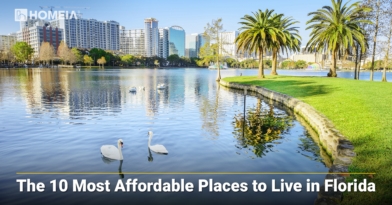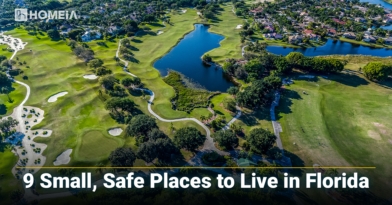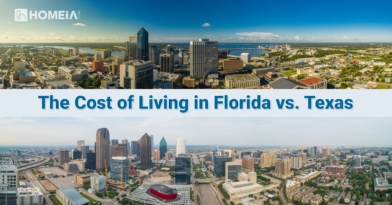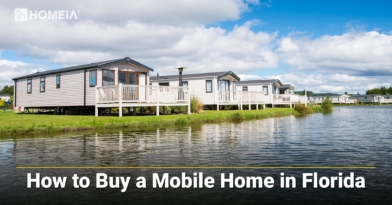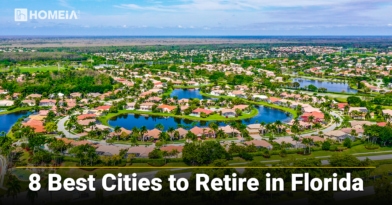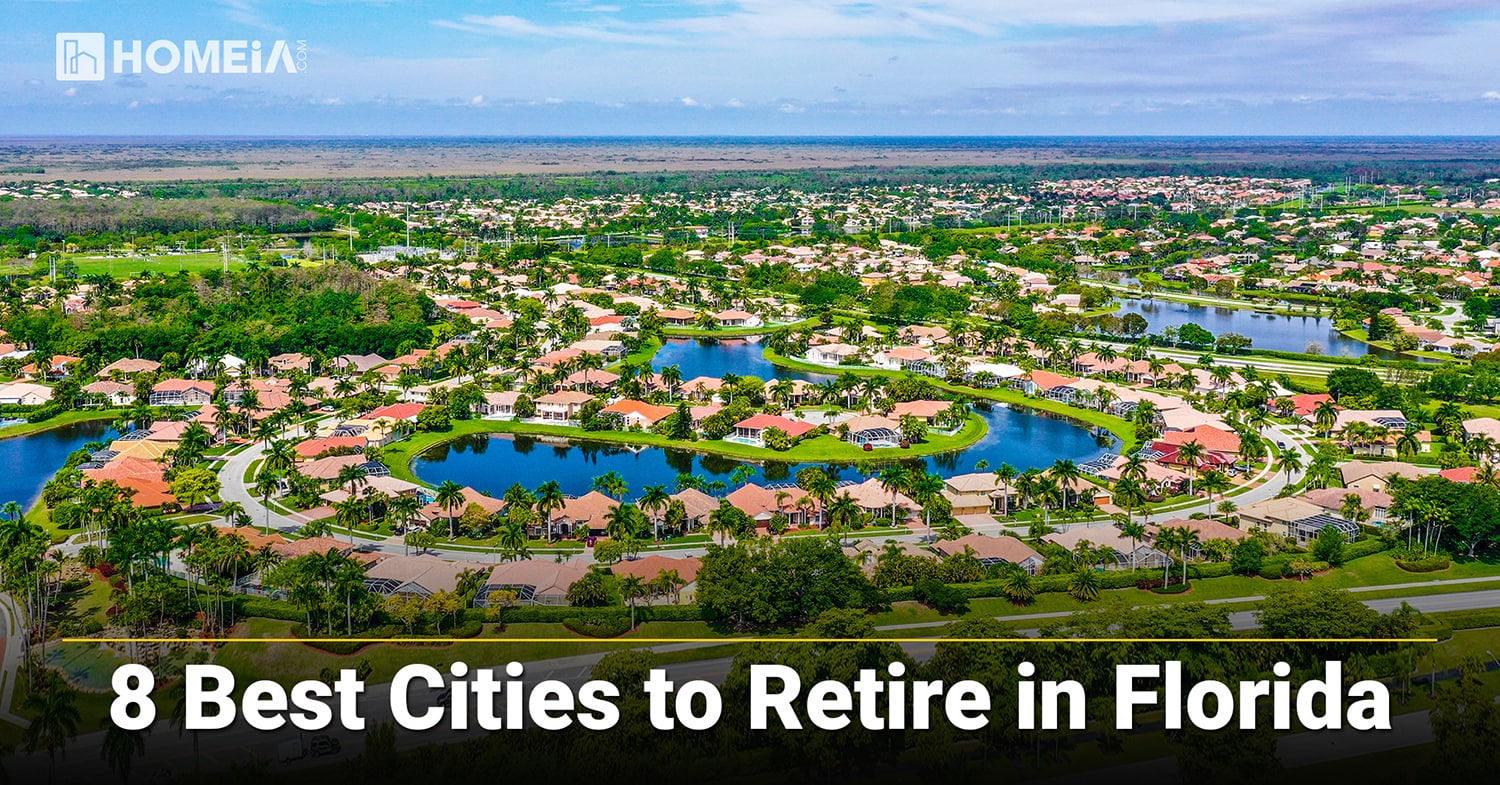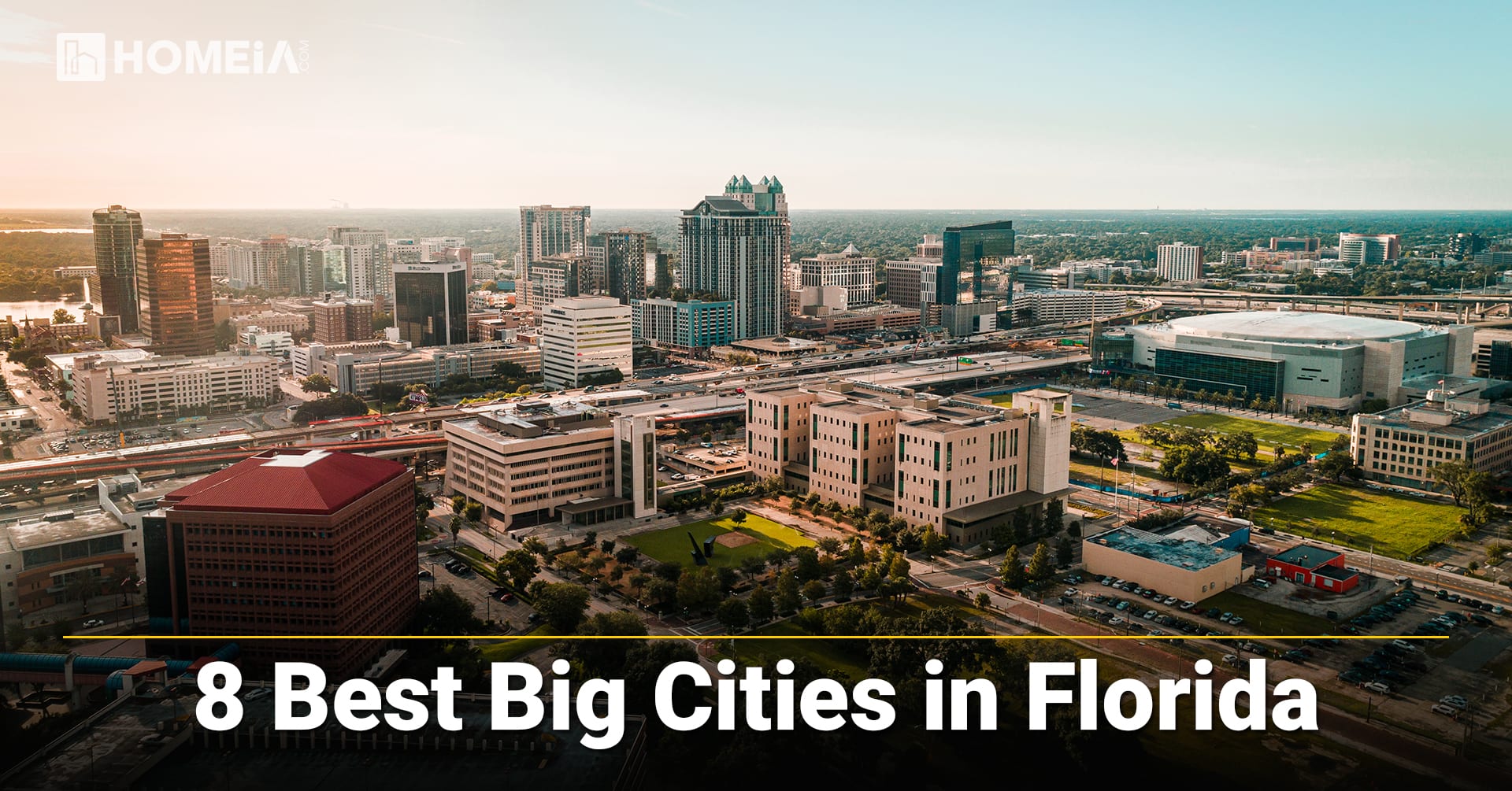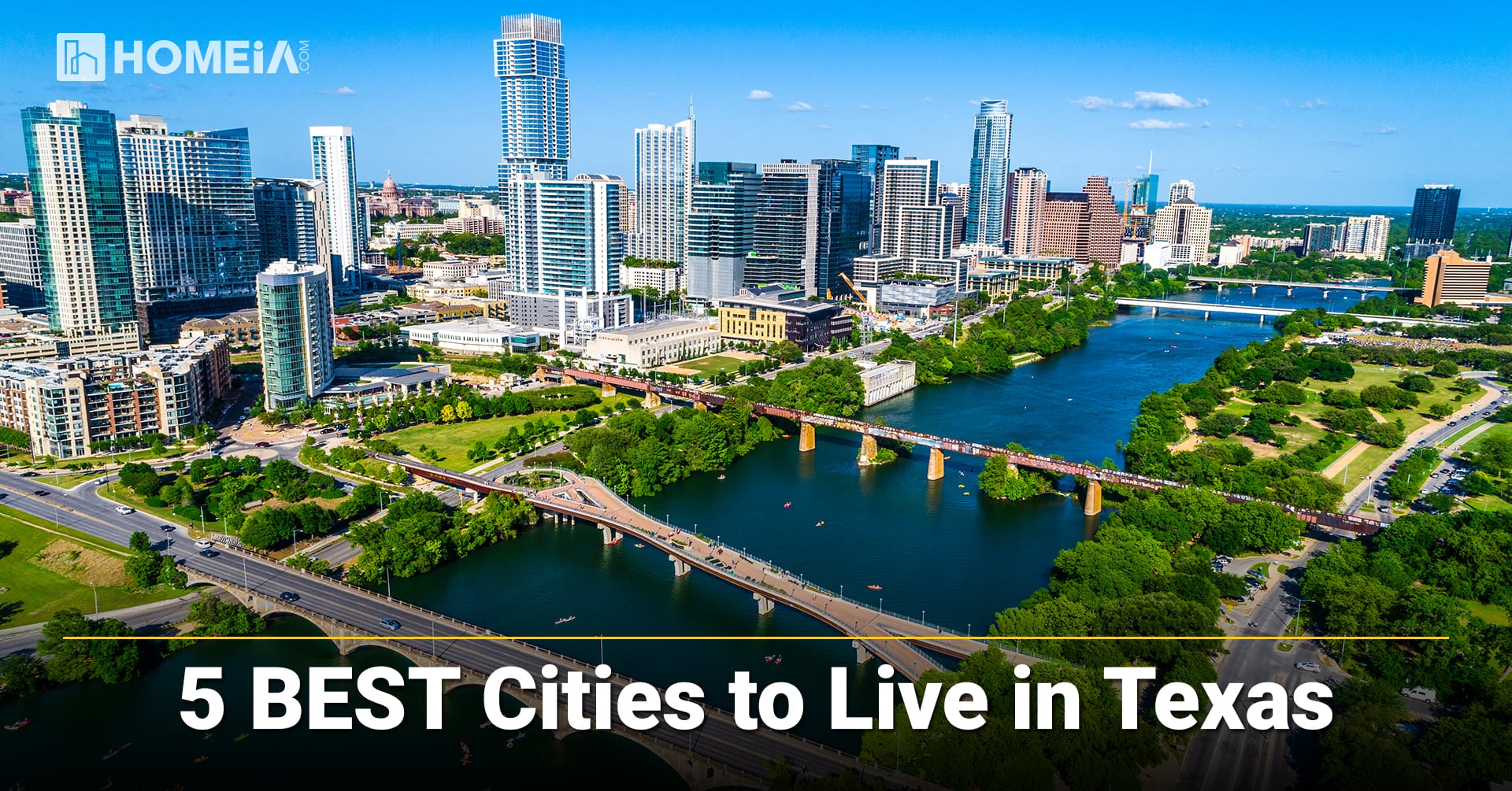Pros and Cons of Living in Florida
- Author:by The HOMEiA Team
- Category: City Living Guide
Choosing to relocate can be quite overwhelming. Once you decide on a state, you still need to choose the right community. If you’ve decided to make Florida your new home, you’re in luck – it’s a big and varied place, with something for all ages, family dynamics and budget.
Continue reading as we dive into some notable Pros and Cons about the state itself, the top cities to live in across a variety of categories, and a handy moving checklist.
In Section I below, we cover some of the many advantages of living in Florida, along with a few drawbacks you should be aware of and some fun facts.
In Sections II through IV, we examine some great destinations for the following groups:
- II. Young professionals just starting out
- III. Couples who have young kids
- IV. Retired folks looking to live out their golden years in the warm weather
For each community within Sections II through IV, we assign a score, which provides an overall assessment – based on affordability, employment, lifestyle, healthcare, education and other relevant factors – of the city’s appeal as a place to call home. Finally, in Section V, we look at a checklist for moving – some of the most important items to take care of when you relocate.
Continue reading below for an overview of the top pros and cons of living in Florida.
Table of Contents:
Pros and Cons of Living in Florida
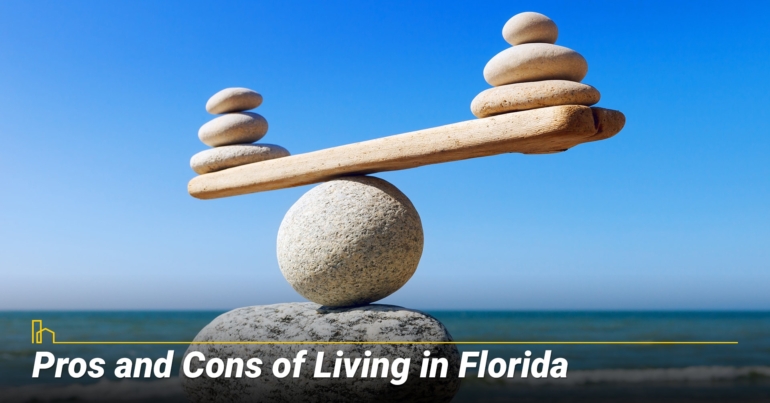
As with any state, there are pros and cons to living in Florida. But as people often say, a bad day in Florida is still better than a good day anywhere else. Let’s look at some of the pros and cons side by side.
Pros
- a) You are never more than 60 miles from a beach in Florida. With nearly 1,200 miles of coastline, it is no wonder that a common phrase is “You can shake the sand from your shoes but not from your soul.”
- b) Florida has managed to stay affordable while attracting people from all over the country at a tremendous rate. Florida’s population grew by 14.2% over the past decade, which is more than double the national rate of 6.3%.
- c) At the same time, Florida’s median home price is still slightly below the national median ($215,300 vs. $217,500).
- d) Florida is one of nine states that don’t have an income tax. Save some money by moving to the Sunshine State!
- e) Many areas of Florida are extremely diverse. Foreign-born persons make up over 50% more of the population in Florida than in the U.S. in general (20.7% as opposed to 13.6%).
- f) There are plenty of theme parks in the state of Florida, including the biggest in the world: The Walt Disney World Resort. With over 40 square miles of parks, resorts, bars, dining and shopping, there’s always something to do.
- g) Don’t assume beaches are the only nature Florida has to offer. With over 200 state parks to visit, be sure that you make plenty of time to see the natural springs, lakes, rivers and hiking trails all across the state.
- h) And then there’s golf, golf and more golf! Naples claims to be the “Golf Capital of the World,” with more holes per capita than any other community. In addition, with more than 160 golf courses, Palm Beach County has more golf courses than any other county in the U.S.
10 Most Affordable Places to Live in Florida in 2024
With year-round warm weather and over 8,000 miles of coastline, it’s no wonder Florida is a prime vacation destination. Filled with wildlife, beaches, lakes, rivers, amusement parks, diverse entertainment options and much more, the population of Florida is growing with people that want to call Florida “home,” soak up the sun…
Cons
- a) Infestations can sometimes be a huge problem in Florida. Bugs, critters and small reptiles such as snakes can cause issues. On the plus side, typically these creatures are more annoying than deadly and can be taken care of by working with the right exterminator.
- b) Florida weather can be a struggle for those not used to it. The heat index in the summer can exceed 110 degrees Fahrenheit, and the relative humidity is sometimes around 90%. Hurricanes can be devastating as well, but the good news is that they are predictable, and Floridians are pros at preparing for any storm.
- c) Certain parts of the state can become overrun by tourists throughout the year. One good thing is that once you start noticing trends, you’ll be able to avoid crowds and crazy out-of-towners. Get ready to hear “Some call it a vacation; I call it home.”
Finally, here are some fun facts about Florida!
- a. The phrase “cool as a cucumber” originates in Florida. On a hot Florida day, the pulp of a cucumber can be up to 10 degrees cooler than the surrounding air.
- b. The first commercial refrigeration was used in Florida.
- c. The Florida Everglades is the only place in the world where alligators and crocodiles coexist.
- d. Miami Beach pharmacist Benjamin Green invented the first sunscreen in 1944.
- e. The first commercial flight took place in 1914 between Tampa and St. Pete.
- f. Gatorade was named after a drink developed for the Florida Gators.
Recommended for you
The 8 Best Places Near the Beach for Retirees in Florida

The following 8 cities are great places for retirees to spend their golden years, soaking up the heat and enjoying the many attractions of Florida. These towns have older populations, good amenities, decent to good healthcare and better safety ratings than many other cities in Florida.
While some of these communities are affordable, others are more luxurious. We have presented options that will fit different budgets and needs, so there should be a choice for everyone.
We have listed the cities below from lowest to highest cost of living. As described at the outset, the rankings and HOMEiA index scores are based on a larger set of characteristics that we have reviewed.
1. Palm Coast
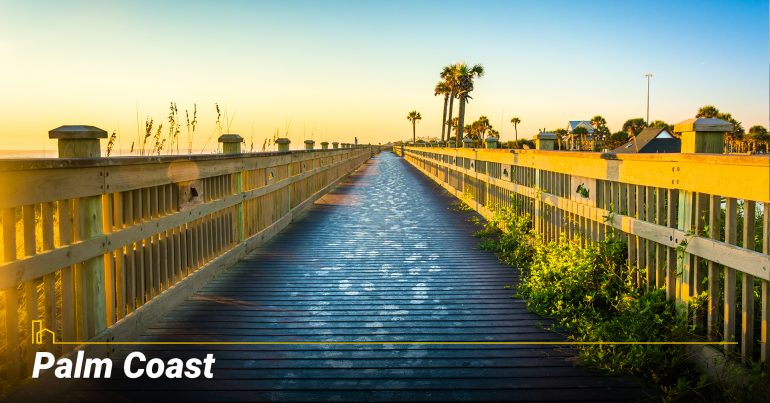
HOMEiA Score: 85/100
- Population: 89,800 | Rank Last Year: #5
- Cost of Living: 4% below the U.S. national average
- Home price to income ratio: $209,300/$54,360 = 3.85 (buying homes is affordable)
- Income to rent ratio: $54,360 /$15,576 = 3.49 (renting homes is affordable)
Palm Coast is located about an hour south of Jacksonville on the east coast of Florida. The population in Palm Coast grew by 19.4% from April 2010 through July 2019 (U.S. Census), substantially above the overall U.S. rate of 6.3% and also the Florida rate of 14.2%.
The median household income in Palm Coast is $54,360, and the median home price is $209,300 (2019 estimates). The unemployment rate is 5.0% (May 2021), which is below the U.S. national rate of 5.8% but just above the Florida rate of 4.9%.
Palm Coast is home to plenty of parks, golf courses and beaches. This area is great for those looking to live an active lifestyle. St. Augustine is a 45-minute drive and a great weekend getaway option.
Advent Health Palm Coast is a great place to find care for a variety of medical needs. According to HealthGrades.com, 65% of patients would recommend this location.
2. Clearwater
HOMEiA Score: 77/100
- Population: 116,948 | Rank Last Year: #8
- Cost of Living: 2% below the U.S. national average
- Home price to income ratio: $206,300/$48,691 = 4.24 (buying homes is slightly expensive)
- Income to rent ratio: $48,691/$13,104 = 3.72 (renting homes is affordable)
Clearwater is a coastal town off the Gulf of Mexico and Tampa Bay. The population in Clearwater grew by 7.2% from April 2010 through July 2019 (U.S. Census), above the overall U.S. rate of 6.3% but below the Florida rate of 14.2%.
The median household income in Clearwater is $48,691, and the median home price is $206,300 (2019 estimates). The unemployment rate is 4.6% (May 2021), which is below both the U.S. national rate of 5.8% and the Florida rate of 4.9%.
Downtown Clearwater is a great place for the whole family. Visit Moccasin Lake Nature Park or the Clearwater Marine Aquarium for more fun and learning.
Morton Plant Hospital is the main medical facility serving the Clearwater area. According to HealthGrades.com, over 82% of patients would recommend this location.
The 9 Cheapest and Safest Places to Live in Florida in 2024
Get ready to explore some of Florida’s safest small communities for the affluents. From coastal towns to pleasant inland locations, there will surely be something for everyone who can afford the lifestyle…
3. Venice
HOMEiA Score: 90/100
- Population: 23,985 | Rank Last Year: #2
- Cost of Living: 1% above the U.S. national average
- Home price to income ratio: $252,200/$60,086 = 4.20 (buying homes is slightly expensive)
- Income to rent ratio: $60,086/$16,260= 3.70 (renting homes is affordable)
Venice is located on the west coast of Florida, a little over an hour south of Tampa. The population in Venice grew by 15.3% from April 2010 through July 2019 (U.S. Census), above the overall U.S. rate of 6.3% as well as the Florida rate of 14.2%.
The median household income in Venice is $60,086, and the median home price is $252,200 (2019 estimates). The unemployment rate is 4.2% (May 2021), which is below both the U.S. national rate of 5.8% and the Florida rate of 4.9%.
Venice is home to a beautiful and welcoming historic downtown area that boasts many shopping and dining venues. There are also plenty of options if you’re looking for nature views.
Venice Regional Bayfront Health offers many different kinds of care. According to HealthGrades.com, over 50% of patients would recommend this location.
4. The Villages
HOMEiA Score: 90/100
- Population: 51,442 (2010) | Rank Last Year: #3
- Cost of Living: 3% above the U.S. national average
- Home price to income ratio: $283,300/$63,841 = 4.44 (buying homes is slightly expensive)
- Income to rent ratio: $63,841/$20,196 = 3.16 (renting homes is slightly expensive)
The Villages are located about an hour northwest of Orlando. The last population report (from 2010) shows that over 50,000 people live in this retirement community.
The median household income in The Villages is $63,841, and the median home price is $283,300 (2019 estimates). The unemployment rate is 5.8% (May 2021), which is on par with the U.S. national rate of 5.8% and above the Florida rate of 4.9%.
The activities inside The Villages include sports, social groups, community events and educational opportunities, as well as amenities like three town squares and several recreation centers. For a day trip, visit the lakes around the area or Ocala National Forest.
The Villages have plenty of healthcare facilities, including AdventHealth, The Villages Center for Health, The Villages Regional Hospital and UF Health The Villages Hospital.
The Cost of Living in Florida vs. Texas
Texas and Florida are vast and have hundreds of communities to choose from. But what are the pros and cons of living in each state? Come with HOMEiA as we explore 7 crucial factors that reveal the true costs of choosing Florida or Texas as your new home…
5. New Smyrna Beach
HOMEiA Score: 84/100
- Population: 27,843 | Rank Last Year: #6
- Cost of Living: 7% above the U.S. national average
- Home price to income ratio: $256,100/$57,043 = 4.49 (buying homes is slightly expensive)
- Income to rent ratio: $57,043/$13,548 = 4.21 (renting homes is affordable)
New Smyrna Beach is a small town on the east coast of Florida, just south of Daytona Beach. The population in New Smyrna Beach grew by 18.8% from April 2010 through July 2019 (U.S. Census), above the overall U.S. rate of 6.3% and the Florida rate of 14.2%.
The median household income in Smyrna Beach is $57,043, and the median home price is $256,100 (2019 estimates). The unemployment rate is 5.0% (May 2021), which is below the U.S. national rate of 5.8% but just above the Florida rate of 4.9%.
New Smyrna Beach has a large variety of activities. Visit the Smyrna Dunes Park, Sugar Mills Ruins or the Marine Discovery Center to learn about the history and nature of this area. For a different adventure, the New Smyrna Speedway is a great attraction.
AdventHealth New Smyrna Beach is a popular healthcare option for those in this area. According to HealthGrades.com, over 60% of patients would recommend this location.
6. Naples
HOMEiA Score: 96/100
- Population: 22,088 | Rank Last Year: #1
- Cost of Living: 12% above the U.S. national average
- Home price to income ratio: $988,500/$107,013 = 9.23 (buying homes is expensive)
- Income to rent ratio: $107,013/$16,284 = 6.57 (renting homes is very affordable)
Naples is located in south Florida on the west coast of the state. The population in Naples grew by 13.2% from April 2010 through July 2019 (U.S. Census), above the overall U.S. rate of 6.3% but below the Florida rate of 14.2%.
Naples has a very high proportion of seniors, with 52.5% of the population being over 65 years of age (2010). This is very high compared to both the U.S. (16.5% seniors) and Florida (26.8% seniors). By comparison, only 8.1% of the population is under 18 years of age, compared to 22.3% in the U.S. and 16.8% in Florida.
The median household income in Naples is $107,013, and the median home price is $988,500 (2019 estimates). The unemployment rate in Naples is 3.7% (May 2021), which is below both the U.S. national rate of 5.8% and the Florida rate of 4.9%.
Naples is home to lovely beaches and sunsets as well as gulf views in many places. Visit museums such as the Baker Museum or take a walk on one of the nature trails in the area. The nation’s smallest post office is located in Ochopee, Florida, near Naples.
The NCH Baker Hospital Downtown offers a variety of healthcare services. According to HealthGrades.com, over 65% of patients would recommend this location.
8 Key Steps to Buy Mobile Home in Florida
We’ll guide you in your research as you talk to other mobile homeowners in Florida: Think about how you’ll prioritize price and luxury, get to know the relevant laws, find places to shop, look into different manufacturers, and think about natural conditions in your area…
7. Boca Raton
HOMEiA Score: 88/100
- Population: 99,805 | Rank Last Year: #4
- Cost of Living: 21% above the U.S. national average
- Home price to income ratio: $458,600/$83,114 = 5.52 (buying homes is expensive)
- Income to rent ratio: $83,114/$21,120 = 3.94 (renting homes is affordable)
Boca Raton is a coastal town located between Fort Lauderdale and West Palm Beach. The population in Boca Raton grew by 18.2% from April 2010 through July 2019 (U.S. Census), above the overall U.S. rate of 6.3% as well as the Florida rate of 14.2%.
The median household income in Boca Raton is $83,114, and the median home price is $458,600 (2019 estimates). The unemployment rate in Boca Raton is 4.6% (May 2021), which is below both the U.S. national rate of 5.8% and the Florida rate of 4.9%.
Boca Raton comes from the Spanish “Boca de Ratones,” meaning “rat’s mouth” – a term used by seamen to describe hidden rocks that could damage a ship. This area is home to plenty of different amenities and activities for those of all ages. Relax at the beach, visit the Boca Raton Museum of Art, or take a walk on the nature trails offered throughout the city.
The Boca Raton Regional Hospital is the main hospital in this area. According to HealthGrades.com, over 75% of patients would recommend this location.
8. Saint Pete Beach
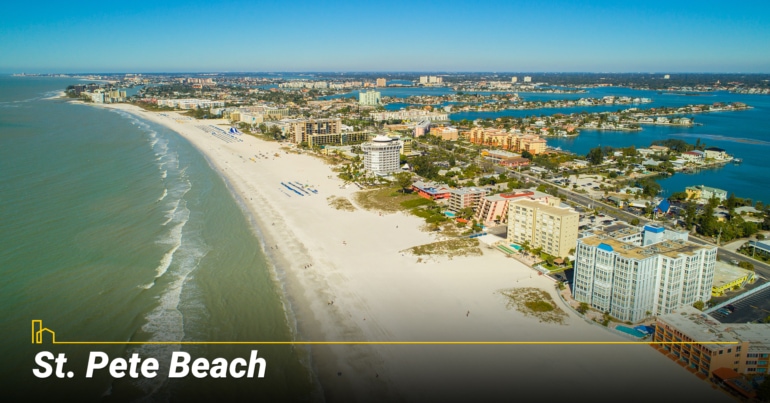
HOMEiA Score: 84/100
- Population: 9,587 | Rank Last Year: #7
- Cost of Living: 30% above the U.S. national average
- Home price to income ratio: $462,500/$76,516 = 6.04 (buying homes is expensive)
- Income to rent ratio: $76,516/$13,236 = 5.78 (renting homes is very affordable)
St. Pete Beach is located on a barrier island just off the coast of St. Petersburg and Tampa Bay. The population in St. Pete Beach grew by 2.6% from April 2010 through July 2019 (U.S. Census), below the overall U.S. rate of 6.3% and the Florida rate of 14.2%.
The median household income in St. Pete Beach is $76,516, and the median home price is $462,500 (2019 estimates). The unemployment rate is 4.6%, which is below both the U.S. national rate of 5.8% and the Florida rate of 4.9%.
St. Pete Beach is almost entirely surrounded by waterfront views. Visit the small parks on the island for more nature watching or check out the bar and dining options offered all over the town.
There are no major hospitals on the island of St. Pete Beach, but there are plenty close by. St. Anthony’s Hospital is highly rated and has a variety of services available. According to HealthGrades.com, over 80% of patients would recommend this location.
Recommended for you
Moving to Florida? Our Relocation Checklist Will Help You Cover Your Bases

If you’re planning on relocating in the near future, there are lots of things to get done so that the entire process runs smoothly. Follow these steps to ensure that your relocation will be as stress-free as possible.
Step One: Organization
- Block time on your calendar to prepare for the move. Take time off work, cancel appointments and make sure the time is available to only focus on the move.
- Set a budget for how much you’d like to spend. Consider moving supplies, moving trucks, overnight stays and any other expense to make everything run smoothly.
Step Two: Planning
- Go through all your belongings and decide what items to bring and what items to get rid of. Consider donating old pieces and purchasing new ones at your destination to save space in the truck.
- Research and hire a moving company that you can trust with your large pieces of furniture. Decide if you’ll also drive some of the belongings to your new location.
- Prepare to change your address and have your mail forwarded on the correct date.
Step Three: Packing
- Begin packing lesser-used items first so you are not struggling during the last few days in your current location.
- Clean and prepare your home before the movers come so they can efficiently pack large furniture items.
- Ensure that you have essentials with you so that you are comfortable right away. This is especially important if the moving trucks won’t arrive until a day or two later.
Step Four: The Move
- Keep an ongoing list of things to remember for the day of the move, including any stops you might make along the way.
- Make sure everyone is comfortable on the journey, including any pets or kids who are making the trip.
Step Five: Settling In
- Once all your belongings have made it to your new location, begin unpacking and getting settled.
- Make it a point to explore your new town, even if it’s just taking a walk or a short drive to see the new sights.
- Set up appointments to register your car (if you are in a new state) and update your driver’s license.
Conclusion
As you can see, there are plenty of great cities to live in around the state of Florida. Whether you are a young professional just starting out, have recently started a family, or are looking to retire, we hope this guide is helpful as you take the first step on this journey.
The 8 Best Places to Live in Florida For Retirees in 2024
We have presented options that will fit different budgets and needs – there should be a choice for everyone. We have listed the most affordable cities first, though the ranks and index scores are assigned based on a larger set of characteristics that we have reviewed…
